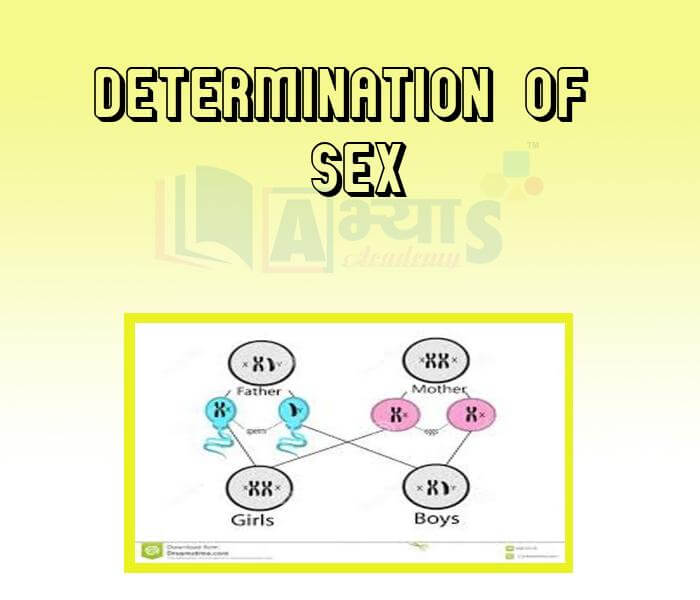Determination of Sex







Determination of Sex
Sex Determination: A person can have either a male sex or a female sex. The process by which sex of a newborn individual is determined is called sex determination. There are different strategies by which sex is determined in different species. In some species, environmental factors are important in determining the sex of the developing individual.
In human beings, sex is determined by genetic inheritance. Genes inherited from the parents determine whether an offspring will be a boy or a girl. Genes for all the characters are linearly arranged on chromosomes. These include the genes for sexual characters. Generally, characters related to the reproductive system are called sexual characters and those that are not are called vegetative characters. The chromosomes that carry genes for sexual characters are called sex chromosomes, while those that carry genes for the vegetative characters are called autosomes.
A sex chromosome that carries the genes for male characters is called Y chromosome and one which carries the genes for female characters is called X chromosome. We have a total of 46 chromosomes. Half of them come from the mother and the rest, from the father.
Out of these 46 chromosomes, 44 are autosomes and 2 are sex chromosomes. The sex chromosomes are not always a perfect pair. In females there are 44 autosomes and two X chromosomes. In males there are 44 autosomes, one X chromosome and one Y chromosome. So the chromosomes in woman are 44+ XX, while the chromosomes in man are 44+ XY.
All children obtain either chromosome from both parents. Females have a perfect pair of sex chromosome (homogametic) and thus, contribute X-chromosome to both the sexes of progeny but males have a mismatched pair (heterogametic) in which one is X (normal sized) and the other is V-chromosome (short in size).
Hence, an egg fertilised by X carrying sperm results in a zygote with XX, which becomes a female and if an egg is fertilised by Y carrying sperm, it results in a XY zygote that becomes male. Thus, the sex of the children will be determined by what they inherit from their father. A child who inherits an X-chromosome will be a girl and one who inherits a V-chromosome will be a boy.
Role of environment in sex determination: Environmental conditions such as temperature around the developing embryo may determine sex in some animals. Such conditions may override the genetic basis, Some animals such as snails can even change their sex, showing that their sex is not genetically determined. Incubation of the eggs of the turtle Chrysema picta at a high temperature produces females. But the incubation of the eggs of the lizard Agama agama at a high temperature produces males
Which one is found in male only? | |||
| Right Option : B | |||
| View Explanation | |||
How many sex chromosomes are present in a human cell? | |||
| Right Option : A | |||
| View Explanation | |||
Which combination of sex chromosomes is present in a male? | |||
| Right Option : B | |||
| View Explanation | |||
Students / Parents Reviews [10]
My experience was very good with Abhyas academy. I am studying here from 6th class and I am satisfied by its results in my life. I improved a lot here ahead of school syllabus.

Ayan Ghosh
8thAbhyas is a complete education Institute. Here extreme care is taken by teacher with the help of regular exam. Extra classes also conducted by the institute, if the student is weak.

Om Umang
10thA marvelous experience with Abhyas. I am glad to share that my ward has achieved more than enough at the Ambala ABHYAS centre. Years have passed on and more and more he has gained. May the centre flourish and develop day by day by the grace of God.

Archit Segal
7thBeing a parent, I saw my daughter improvement in her studies by seeing a good result in all day to day compititive exam TMO, NSO, IEO etc and as well as studies. I have got a fruitful result from my daughter.

Prisha Gupta
8thMy experience with Abhyas academy is very good. I did not think that my every subject coming here will be so strong. The main thing is that the online tests had made me learn here more things.

Hiya Gupta
8thIt was good as the experience because as we had come here we had been improved in a such envirnment created here.Extra is taught which is beneficial for future.

Eshan Arora
8thAbhyas Methodology is very good. It is based on according to student and each child manages accordingly to its properly. Methodology has improved the abilities of students to shine them in future.

Manish Kumar
10thIt has a great methodology. Students here can get analysis to their test quickly.We can learn easily through PPTs and the testing methods are good. We know that where we have to practice

Barkha Arora
10thOne of the best institutes to develope a child interest in studies.Provides SST and English knowledge also unlike other institutes. Teachers are co operative and friendly online tests andPPT develope practical knowledge also.

Aman Kumar Shrivastava
10thIt was a good experience with Abhyas Academy. I even faced problems in starting but slowly and steadily overcomed. Especially reasoning classes helped me a lot.
